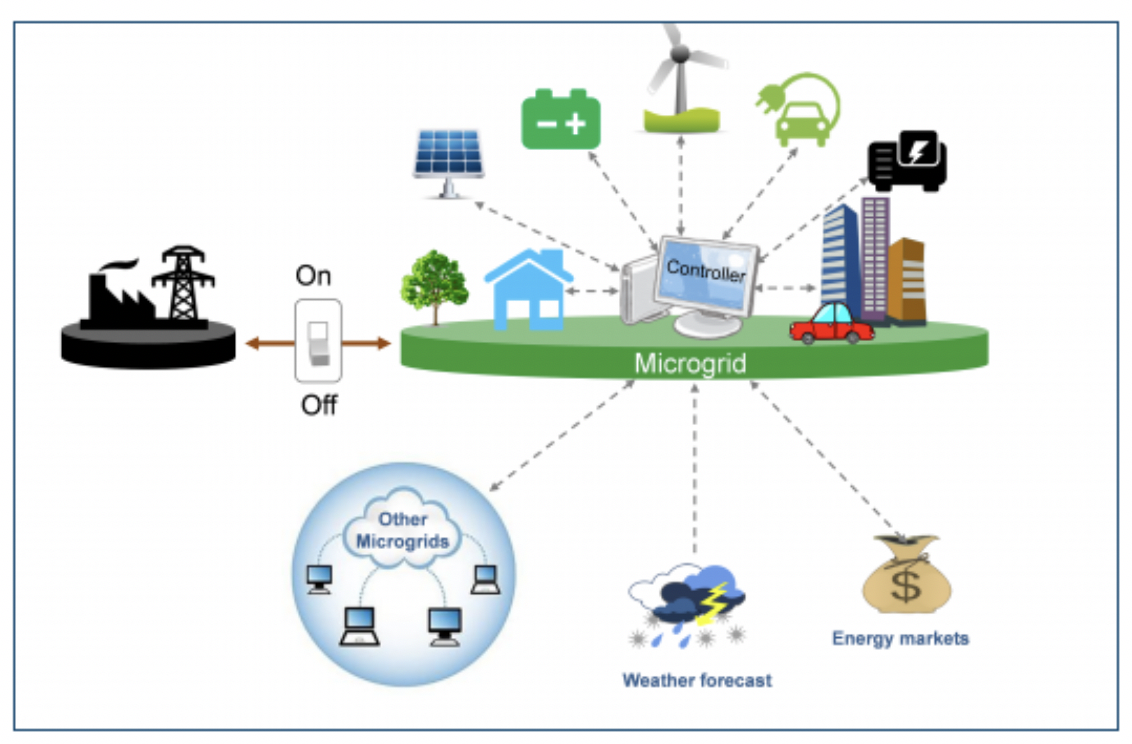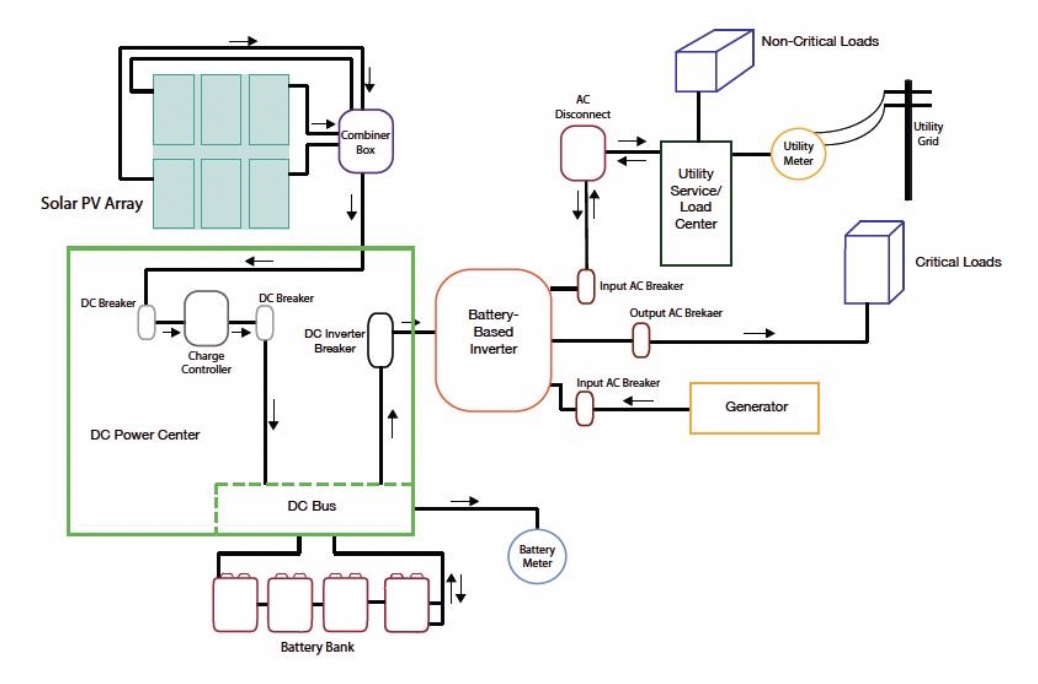Solar Islanding and Microgrid-Ready Solar PV
New CommercialWhat is Solar Islanding and Microgrid-Ready Solar PV?
Photovoltaic (PV) systems are semiconductor devices that use renewable solar energy to create electricity (see Photovoltaic (PV) systems).[1] Most grid-tied PV systems connect to the traditional centralized grid or macrogrid and loose power whenever the large-scale electric power system goes down.[2] Islanding refers to when a distributed energy resource (DER), such as a PV system, continues to power a location with available solar even after a grid outage. Laws typically require grid-tied PV systems to have a grid-tie inverter with an anti-islanding capability, which can sense when a power outage occurs, automatically disconnect from the grid, and shut itself off, protecting utility workers from live wires and preventing power surges.[3]

Figure 1. Diagram of a typical microgrid configuration. (Source: NREL https://building-microgrid.lbl.gov/about-microgrids-0
Unlike the traditional macrogrid, microgrids function as locally controlled systems (see Figure 1) and can allow for intentional solar islanding or operating independently of the grid.[4] The United States Department of Energy Microgrid Exchange Group defines a microgrid as:[5]
“A microgrid is a group of interconnected loads and distributed energy resources (DER) within clearly defined electrical boundaries that acts as a single controllable entity to the grid. A microgrid can connect and disconnect from the grid to enable it to operate in both grid-connected or island-mode.”
Microgrids can operate at different scales or classifications based on the size and organization of the Distributed Energy Resources (DER) connected to the grid. For example, Level 1 or single customer microgrids may include PV systems that serve one customer or building through a single meter.
PV systems with solar islanding capability and battery storage can provide emergency power for critical building functions during grid outages and emergency situations (see Energy Storage and Backup Power Generation). They can also function independently of the traditional grid during the year to manage peak demand and energy prices through participation in Demand Response (DR) programs (see Demand Response and Peak Load Management). Likewise, PV systems designed to connect to local or future microgrid connections helps support the development of the broader smart grid by providing a local, distributed energy resource and helping to manage power outages, peak demand, and the integration of clean and renewable energy to the grid (see Smart Metering, and Demand Response and Peak Load Management).
How to Implement Solar Islanding and Microgrid-Ready PV
Reconfiguring PV systems to operate independently of the grid and serve as self-sufficient microgrids requires investments in additional hardware and software components, including transfer switches, inverters, critical load panels, battery storage, and appropriate controls to allow successful solar islanding to take place (see Energy Storage and Backup Power Generation).[6]
First, analyze power demands and associated functions that would benefit from solar islanding. Distinguish between critical loads, such as providing basic heating and ventilation, cooking and food storage, lighting, and phone or laptop charging versus non-critical loads such as full-capacity heating and ventilation, lighting, cooking, refrigeration, and television or other electronic entertainment and devices.[7] See the Highland Park Solar Islanding example below for advice on calculating critical loads and determining capacity requirements for an islandable PV and battery storage system.

Figure 2 – Typical grid-tied islanding system (source: www.aeesolar.com/sites/default/files/Graph-grid- tie-battery-backup.jpg). The solar array includes DC coupled battery storage with the potential for adding supplemental generation sources.
Hire a professional, licensed contractor to design and install the photovoltaic system, and help with paperwork for any tax credits and rebates or other incentives.[8] Contact the NJ Office of Clean Energy to learn about current programs, tools, and available funding. Funding and incentive programs may require islandable PV and battery storage systems to blackstart or startup without a direct connection to the electric utility grid and operate at critical load for a set minimum period.[9]
Examples
Solar Islanding Project, Highland Park, NJ.
This report analyzes the power demands and associated functions potentially sustained by three existing solar installations in Highland Park, NJ if converted into solar power islands. The report includes recommendations in language consistent with the National Incident Management System (NIMS) standard for adoption by other municipalities who may already have solar islands.
Benefits
Solar islanding and microgrid ready PV systems with battery storage combine the benefit of traditional PV systems, which avoid the use of fossil fuels, while also providing a resilient, local, and independent source of electric power during power emergencies and help to manage peak demand and lower utility costs throughout the year via demand response programs. By providing localized power generation, islandable PV systems increase energy efficiency by reducing transmission and distribution losses typical of centralized grid systems.[10] Unlike diesel and fossil-fueled generators, typically used only during emergencies, islandable PV systems with battery storage provide value throughout the year, do not require regular maintenance or refueling, and can provide emergency power for extended periods of time given available solar resources and adequate battery storage.[11]
Costs
Compared to traditional grid-tied PV systems, islandable PV and battery storage systems require additional hardware and software components, electrical design and permitting requirements, and safety considerations, which translate into higher costs (see Photovoltaic (PV) Systems).[12] As the cost of solar and battery storage declines and power outages become more common, the cost savings from participation in demand response programs, and the resiliency benefits of avoided power outages, such as reduced business closures, health and safety hazards, food spoilage, and inconvenience from schedule disruptions, may offset these incremental costs. [13]
Resiliency
Solar PV systems support energy resiliency in many ways. PV systems with islanding capability and battery storage can operate independently from the grid during outages or at times of system peak and increase grid reliability by managing system outages and peak demand (see Energy Storage and Backup Power Generation). Solar islanding and microgrid ready PV systems support the smart grid, which aims to diversify and strengthen the electric grid through better energy management and the integration of cleaner energy sources such as wind and solar as well as electric vehicle charging and energy storage. PV systems installed high up on buildings or poles are protected from flood waters. PV systems that meet local codes and wind loading requirements are designed to withstand damage and provide a reliable source of power in hurricane zones.[14] Separation from the electricity grid also offers protection from security threats.
[1] E. Hotchkiss, I. Metzger, J. Salasovich, and P. Schwabe. 2013 Alternative Energy Generation Opportunities in Critical Infrastructure New Jersey. Produced under the direction of the U.S. Federal Emergency Management Agency by the National Renewable Energy Laboratory (NREL) https://www.nrel.gov/docs/fy14osti/60631.pdf (accessed Oct 3, 2018).
[2] Highland Park Solar Islanding Project (2015) Prepared for the Borough of Highland Park, NJ by Jennifer Senick, Executive Director, Rutgers Center for Green Building; Dunbar Birnie, Professor of Ceramic Engineering, Department of Materials Science and Engineering; Aman Trehan, Research Graduate Assistant; Nan Chen, Research Graduate Assistant; Deborah Plotnik, Program Coordinator, Rutgers Center for Green Building, Rutgers – The State University of New Jersey. At: http://rcgb.rutgers.edu/wp-content/uploads/2017/12/SolarIslanding_Final-Submitted_7.10.2015-with-Appendices.pdf (accessed Oct 1, 2018).
[3] NREL (2017) Microgrid-Ready Solar PV – Planning for Resiliency. Updated September 2017. https://www.nrel.gov/docs/fy18osti/70122.pdf (accessed Oct 1, 2018).
[4] Lawrence Berkeley Laboratory. 2018. Microgrids at Berkeley Labs. https://building-microgrid.lbl.gov/about-microgrids-0 (accessed Oct 2, 2018).
[5] NJ Board of Public Utilities. 2017. Microgrid. https://www.state.nj.us/bpu/about/divisions/opp/microgrid.html (accessed Oct 1, 2018).
[6] NJ Board of Public Utilities. 2017. Microgrid. https://www.state.nj.us/bpu/about/divisions/opp/microgrid.html (accessed Oct 1, 2018).
[7] Ibid. Highland Park Solar Islanding Project (2015) http://rcgb.rutgers.edu/wp-content/uploads/2017/12/SolarIslanding_Final-Submitted_7.10.2015-with-Appendices.pdf (accessed Oct 1, 2018).
[8] US Department of Energy. “A Consumer’s Guide: Get Your Power from the Sun.” http://www.nrel.gov/docs/fy04osti/35297.pdf (accessed April 5, 2018).
[9] NJ Board of Public Utilities. 2018. Energy Resilience Bank. https://www.state.nj.us/bpu/about/divisions/opp/erb.html (accessed Oct 2, 2018).
[10] E. Hotchkiss, I. Metzger, J. Salasovich, and P. Schwabe. 2013 Alternative Energy Generation Opportunities in Critical Infrastructure New Jersey. Produced under the direction of the U.S. Federal Emergency Management Agency by the National Renewable Energy Laboratory (NREL) https://www.nrel.gov/docs/fy14osti/60631.pdf (accessed Oct 3, 2018).
[11] NREL. 2018. “Valuing the Resilience Provided by Solar and Battery Energy Storage Systems.” https://www.nrel.gov/docs/fy18osti/70679.pdf (accessed Oct 3, 2018).
[12] NREL. 2018. “Valuing the Resilience Provided by Solar and Battery Energy Storage Systems.” https://www.nrel.gov/docs/fy18osti/70679.pdf (accessed Oct 3, 2018).
[13] DOE. “Smart Grid Investments Improve Grid Reliability, Resilience, and Storm Responses.” https://www.smartgrid.gov/files/B2-Master-File-with-edits_120114.pdf (accessed May 1, 2018).
[14] E. Hotchkiss, I. Metzger, J. Salasovich, and P. Schwabe. 2013 Alternative Energy Generation Opportunities in Critical Infrastructure New Jersey. Produced under the direction of the U.S. Federal Emergency Management Agency by the National Renewable Energy Laboratory (NREL) https://www.nrel.gov/docs/fy14osti/60631.pdf (accessed Oct 3, 2018).
